Land trusts gain ground through collaboration
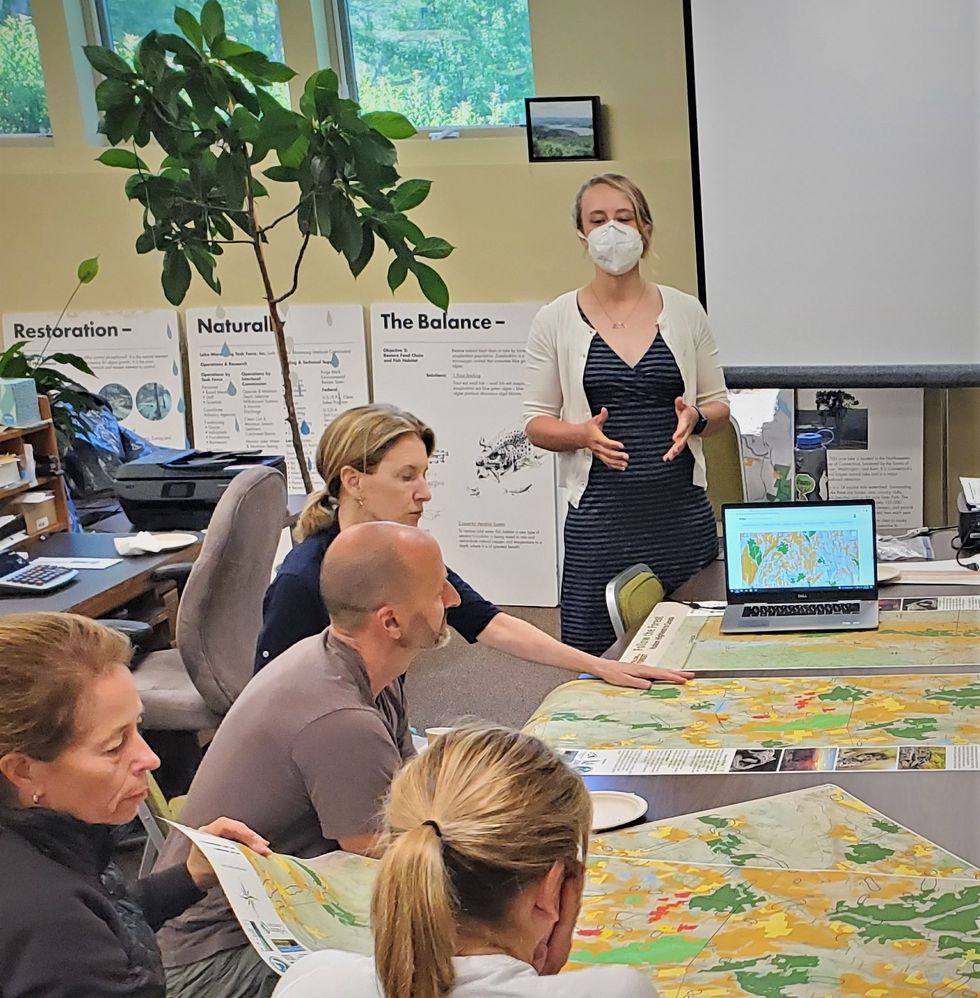
Julia Rogers of the Housatonic Valley Association recently gave a presentation to the Warren Land Trust on strategic land protection priorities.
Photo by Connie Manes

Editor’s note: This is the first of a two-part series focusing on how land trusts in Northwest Connecticut are working in concert to tackle conservation challenges.
The nearly two dozen land trusts in rural Northwest Connecticut may be small, but they are mighty when it comes to collaborative conservation efforts.
A first-of-its-kind research project examining the pace and scale of conservation in the state’s Northwest Corner illustrates the extent of this collaboration.
Working with 19 land trusts, the Kent-based Northwest Connecticut Land Conservancy (NCLC) has collected and documented data showing the total amount of land that has been conserved each year in the region over the past decade.
The publication’s findings, said Catherine Rawson, executive director of NCLC, will serve as a roadmap to future conservation efforts.
“It’s not every day that we release a publication that demonstrates that work. It’s a fantastic vantage point from which to look out into the future and gauge how much land we expect to protect by 2023.”
Northwest Connecticut, said Rawson, is the first and only region in the state to track and prepare data on the pace of its collective conservation efforts.
“We are grateful to work in this community of strong conservation partners. It is so exciting to share the collective summaries of the region’s land trusts and what they are all able to accomplish together,” said the NCLC executive director.
Tim Abbott, Housatonic Valley Association’s (HVA) regional conservation and Greenprint Collaborative director, said he views the new NCLC report, titled “The Pace and Scale of Conservation in Northwest Connecticut” as a much needed “call to action.’
“It’s sobering and inspiring,” said Abbott. “It supports data that is coming in from beyond our region. And that is that we need to be doing more and on a wider scale” to meet the pressures of the changing climate and adverse human impact on the environment.
“If we do it piecemeal,” he said,” that won’t be up to the scale of the threat. You need partners.”
Joining forces
Collaboration among state and Litchfield County land trusts, said those in the field, has gained momentum in the past decade.
In increasing numbers, land trusts have come to realize that partnering with other agencies or larger entities can allow for greater transaction expertise, increased funding opportunities, enhanced credibility, more organizational capacity, shared resources including staff and technology, cooperation on easement stewardships, positive publicity, and increased land protection overall.
“The addition of professional help for land trusts has been huge,” said Bart Jones, president of the 35-year-old Cornwall Conservation Trust, Inc. (CCT), who credited collaboration as a game-changer and said professional help “makes fundraising for conservation work critical.”
He noted that the trend away from all-volunteer land trusts started in earnest about 15 years ago through shared resources and resulted in a heightened level of professionalism and credibility.
“We couldn’t have acquired as much land as we have without it,” said Jones of his organization.
Accreditation, too, has upped the game for land trusts.
“The other thing that has shifted is the emphasis on land trust standards and practices,” said HVA’s Abbott. More than half of the state’s 30 or so accredited land trusts are in the Northwest Corner and belong to the Litchfield Hills Greenprint Collaborative.
“Northwest Connecticut land trusts have taken accreditation very seriously. It gives us a common language and helps us feel comfortable that we are all talking about the same things,” added Connie Manes, Greenprint director and executive director of the Kent Land Trust (KLT).
Regional partnerships
As land conservation becomes more urgent, complex and expensive, land trusts are being creative in expanding their leverage and capabilities by forging regional conservation partnerships with entities like the Cornwall-based HVA, Northwest Connecticut Land Conservancy and others.
For instance, HVA’s Follow the Forest initiative unites land trusts and communities against the persistent threat of forest fragmentation. Important woodland species need room to roam, and unbroken stretches of forested land act as a “wildlife highway,” providing safe habitat and food.
“None of us lives in isolation, which is quite clear when you look at the extensive wildlife corridor of which we are smack in the middle,” noted KLT’s Manes.
“Animals and birds don’t stop at town lines and people don’t either,” said Manes, who owns a private equity consulting firm and chairs the Kent Conservation Commission.
Manes, like many other land trust members interviewed, wear several “hats” in their capacity as conservationists often serving on town land-use boards in addition to volunteering or directing at various nonprofit groups, or as private consultants.
Community outreach targets students
Maria Grace, executive director of the 300-member Sharon Land Trust (SLT), which boasts nine public preserves with 24 miles of hiking trails and includes Kent and Salisbury in its area of operation, stressed the importance of community outreach programs aimed at adults and children.
SLT is a partner of Follow the Forest, a regional initiative that seeks to protect and connect forests and promote the safe passage of wildlife throughout the Northeast, from the Hudson Valley to Canada.
Grace spoke enthusiastically about recent field trips and outdoor adventures held jointly with the Salisbury Association Land Trust (SALT) and HVA’s Paul Singer.
“We educate people about our forests and how they need to better connect them,” said the SLT executive director. Field trips with students include training on how to access connectors and collect data.
Strength in numbers
Land trusts are finding creative ways to support each other.
For example, Kent and Warren conservationists recently joined forces with the purchases of their adjoining preserves, Kent Land Trust’s East Kent Hamlet Nature Preserve and Warren Land Trust’s soon-to-be-open Cunningham Road Preserve.
SLT’s Grace pointed to the 52-acre Tory Hill property, near the Lakeville/Sharon border, as a prime example of successful collaboration with SALT.
Tory Hill was a joint project involving several landowners, the state of Connecticut, and others to preserve a prime scenic vista obscured by rampant spread of invasive plant species.
Working in tandem, the two land trusts collaborated, raised funds and closed on the open space, which is managed by the Salisbury Association.
Double protection on easements
Holding conservation easements on each other’s preserves is also a way land trusts join forces.
“Sometimes it’s desirable to have double protection on a property, where a land trust owns the property, and another land trust holds the conservation easement on it, so both are monitoring the property and making sure it stays preserved,” explained Shelley Harms, a private land consultant since 2014 who serves as executive director of both the Salisbury and Cornwall land trusts.
Harms also volunteers as co-president of the Norfolk Land Trust (NLT) and has assisted several other groups with acquisition grants and accreditation projects.
Speaking of collaboration, she said, “Norfolk Land Trust owns a property that Winchester Land Trust holds the easement on, and Norfolk Land Trust holds an easement on property owned by Colebrook Land Conservancy, also on property owned by Aton Forest, also on property owned by Great Mountain Forest.”
A regional organization like NCLC, Harms pointed out, also has capacity to work in a town where there isn’t a local land trust. She also credited NCLC for hosting Green Drinks, where land trust officials meet informally to discuss various topics, and by hosting the small area land trust meetings.
Shared mapping, monitoring systems
Several land trust leaders also pointed to NCLC’s technology assistance in the form of its shared LENS aerial photo monitoring system.
“Both HVA Greenprint and the Northwest Connecticut Land Conservancy have been helpful to the smaller land trusts,” said Harms. “HVA has a terrific map person, Stacy Deming, who does our conservation maps.”
SLT’s Grace praised the value of a shared satellite monitoring system. “We have about 50 parcels, so it allows us greater flexibility,” particularly when it comes to annual inspections required under the accreditation process, she noted.
“We now have 11 land trusts who use our purchased satellite software to inspect their properties,” reported NCLC’s Rawson.
‘A tightly-knit, collegial group’
The sharing of staff is vital to success, said Manes. Land trusts share not only administrative staff, but also summer interns, bookkeepers, and AmeriCorps teams of service youth.
“We share information about what works in our organizations, examples of policies, procedures and grant applications. We co-sponsor trainings and public educational programs, and we conduct public outreach.”
At one point, she noted, HVA was sharing an administrative person with three different land trusts.
“It may seem byzantine when one first encounters the many organizations working in land conservation in New England, but the people, the countless impassioned volunteers and professionals who work on conservation in our region and throughout Connecticut are a tightly-knit, collegial group.
“We have a head start on collaborative efforts because the trust, relationships and infrastructure for collaboration are already here, built over decades to a place of great strength and opportunity.”
Coming up: Northwest Corner land trusts bear the burden of region’s conservation future.
Cornwall Conservation Trust
(860) 248-3255
cornwallconservationtrust.org
Housatonic Valley Association
Cornwall Bridge
(860) 672-6678
hvatoday.org
Kent Land Trust
(860) 488-9185
ketlandtrust.org
Norfolk Land Trust
(860) 307-8380
norfolklandtrust.org
Northwest Connecticut Land Conservancy
Kent – (860) 927-1927
ctland.org
Salisbury Association Land Trust
(860) 435-0566
www.salisburyassociation.org/land-trust/
Sharon Land Trust
(860) 364-5137
www.sharonlandtrust.org
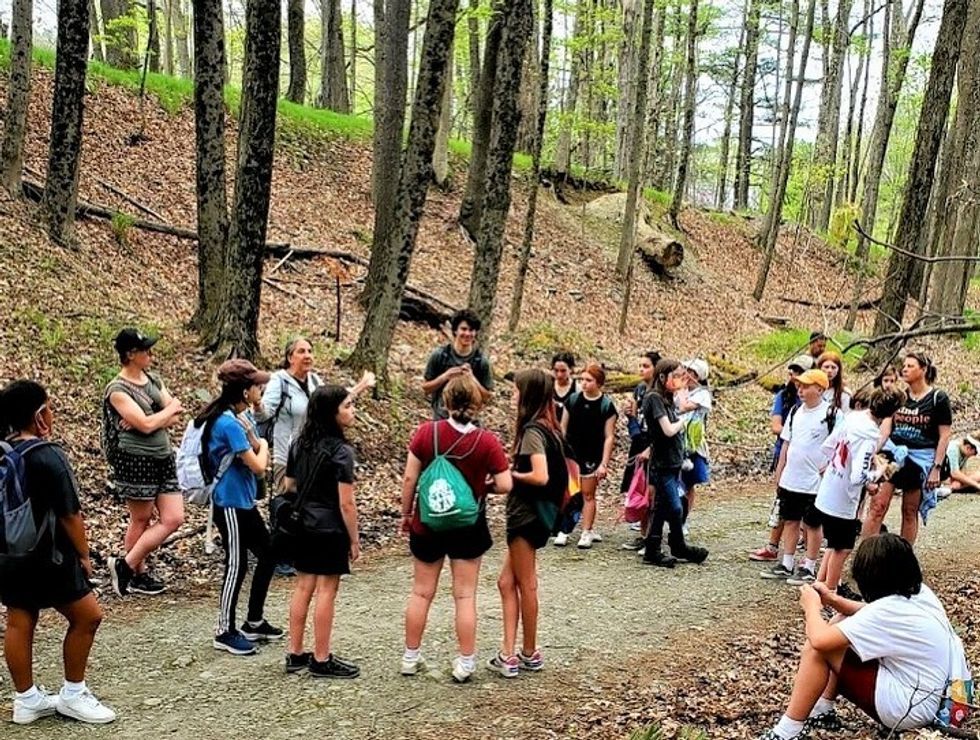
Paul Singer of the Housatonic Valley Association and Diane Fitzmeyer Murphy of the Salisbury Association guided children from Salisbury Central School on a field trip earlier this year focused on habitat connectivity and wildlife corridors. Photo Submitted
Kent Town Hall, where the Inland Wetlands and Watercourses Commission approved the draft settlement.
KENT– A year-and-a-half-long legal dispute over an unpermitted roadway and dock built through wetlands on North Spectacle Pond is approaching a resolution. The KenMont and KenWood summer camp and the town’s Inland Wetlands and Watercourses Commission are close to reaching a mutually acceptable agreement.
The conflict began after the IWWC denied the camp’s retroactive application in March 2024 for the road and dock, which were constructed without town approval sometime last decade. The Commission found both structures violated town regulations, leading the camp to file a legal appeal.
Although most deliberations occurred in executive session, IWWC Chair Lynn Werner announced at the Commission’s Nov. 24 meeting that both sides had found a path forward. “We’ve come to a place where both sides are in agreement,” she said.
The Commission then voted unanimously to approve the settlement, which must now be submitted to the court for final approval. During the meeting, the Commission’s legal counsel, attorney Michael Ziska, explained that the current camp leadership—who were not involved in constructing the roadway or dock—had agreed to terms that would prohibit vehicle traffic on the road, require invasive-species management around it, and allow the IWWC to conduct regular inspections.
Ziska said the former camp leader responsible for building the road has since died, and the new directors are cooperating. He noted the roadway was built largely of logs that are now degrading into the wetland. Expert consultants for both the camp and the IWWC have advised allowing the roadway to be naturally reclaimed by the landscape, with light management to ensure several culverts beneath the structure remain functional.
“I believe that this settlement agreement protects the Commission’s interests,” Ziska said. “[It] recognizes the unique aspects of this particular violation – the number of years it’s been in place, the fact that the person who is responsible is no longer around, and the fact that the consultants have said things should probably be left as is for the time being. All of that commends itself to this draft settlement that we have proposed.”
Wes Allyn breaks away from the St. Paul defense for a reception touchdown Wednesday, Nov. 26.
BRISTOL — The Gilbert/Northwestern/Housatonic co-op football team ended the season with a 34-0 shutout victory over St. Paul Catholic High School Wednesday, Nov. 26.
It was GNH’s fourth consecutive Turkey Bowl win against St. Paul and the final game for 19 GNH seniors.
The Yellowjacket defense played lights out, holding St. Paul’s offense to 73 total yards and forcing three turnovers. Owen Riemer and Tyler Roberts each caught an interception and Jacob Robles recovered a fumble.

QB Trevor Campbell threw for three touchdowns: one to Wes Allyn, one to Cole Linnen and one to Esten Ryan. GNH scored twice on the ground with rushing touchdowns from Linnen and Riemer.
The game concluded in some confusion. A late run by Linnen ended when he was tackled near the end zone. The ball was spotted at the one-yard line and GNH took a knee to end the fourth quarter with the scoreboard reading 28-0. After the game, Linnen’s run was reassessed as a touchdown, and the final score was adjusted to 34-0.

Coach Scott Salius was thankful that his team went out on a high note. “We’re one of the few teams in the state that will finish with a win.” He commented on the “chippiness” of this year’s Thanksgiving matchup. “We have started a true rivalry.”
GNH won four of the last five games and ended with a record of 5-5.
“Battling back from 1-4, huge turnaround. I couldn’t be happier,” said GNH captain Wes Allyn after the win. “Out of the four years I’ve been playing, undefeated on Thanksgiving. No one will ever take that away from me.”

Looking back on his final varsity season, Nick Crodelle said he will remember “practice, complaining about practice, and getting ready for the games. Game day was a lot of fun.”
Hunter Conklin said ending on a win “feels great” and appreciated his time on the field with his teammates. “There’s no one else I’d rather do it with.”
“I’m so thankful to have these guys in my life,” said Riemer. “It’s emotional.”
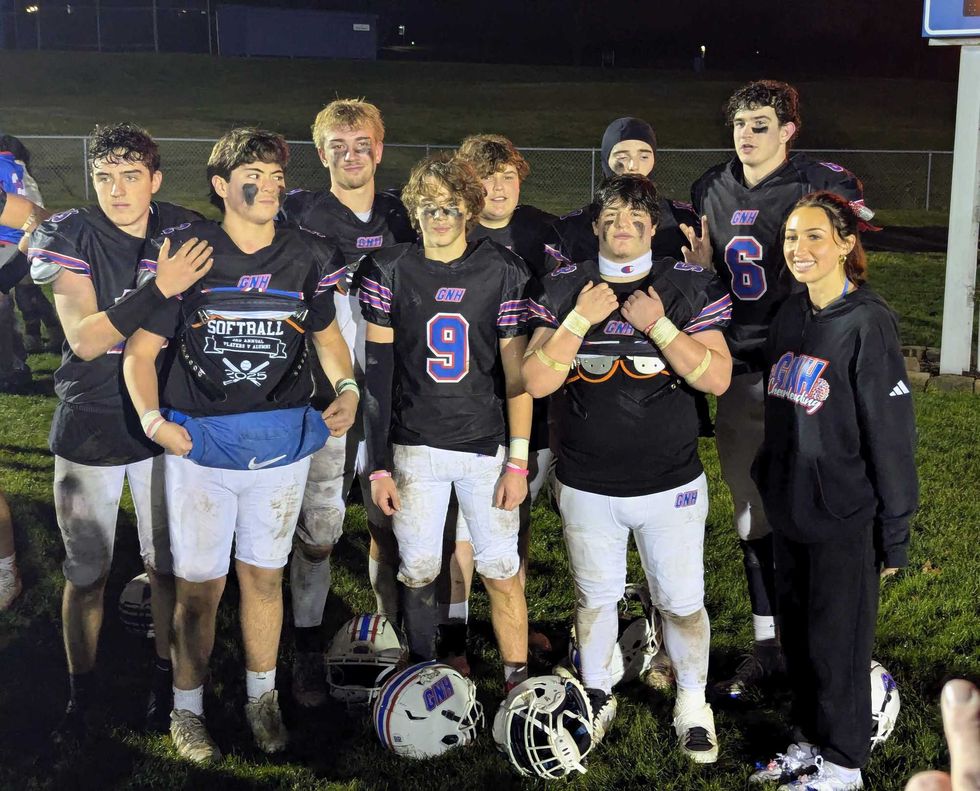
“Once Upon a Time in America” features ten portraits by artist Katro Storm.
The Kearcher-Monsell Gallery at Housatonic Valley Regional High School in Falls Village is once again host to a wonderful student-curated exhibition. “Once Upon a Time in America,” ten portraits by New Haven artist Katro Storm, opened on Nov. 20 and will run through the end of the year.
“This is our first show of the year,” said senior student Alex Wilbur, the current head intern who oversees the student-run gallery. “I inherited the position last year from Elinor Wolgemuth. It’s been really amazing to take charge and see this through.”
Part of what became a capstone project for Wolgemuth, she left behind a comprehensive guide to help future student interns manage the gallery effectively. “Everything from who we should contact, the steps to take for everything, our donors,” Wilbur said. “It’s really extensive and it’s been a huge help.”
Art teacher Lilly Rand Barnett first met Storm a few years ago through his ICEHOUSE Project Space exhibition in Sharon, “Will It Grow in Sharon?” in which he planted cotton and tobacco as part of an exploration of ancestral heritage.
“And the plants did grow,” said Barnett. She asked Storm if her students could use them, and the resulting work became a project for that year’s Troutbeck Symposium, the annual student-led event in Amenia that uncovers little-known or under-told histories of marginalized communities, particularly BIPOC histories.
Last spring, Rand emailed to ask if Storm would consider a solo show at HVRHS. He agreed.
And just a few weeks ago, he arrived — paints, brushes and canvases in tow.
“When Katro came to start hanging everything, he took up a mini art residency in Ms. Rand’s room,” Wilbur said. “All her students were able to see his process and talk to him. It was great working with him.”
Perhaps more unexpected was his openness. “He really trusted us as curators and visionaries,” Wilbur said. “He said, ‘Do with it what you will.’”
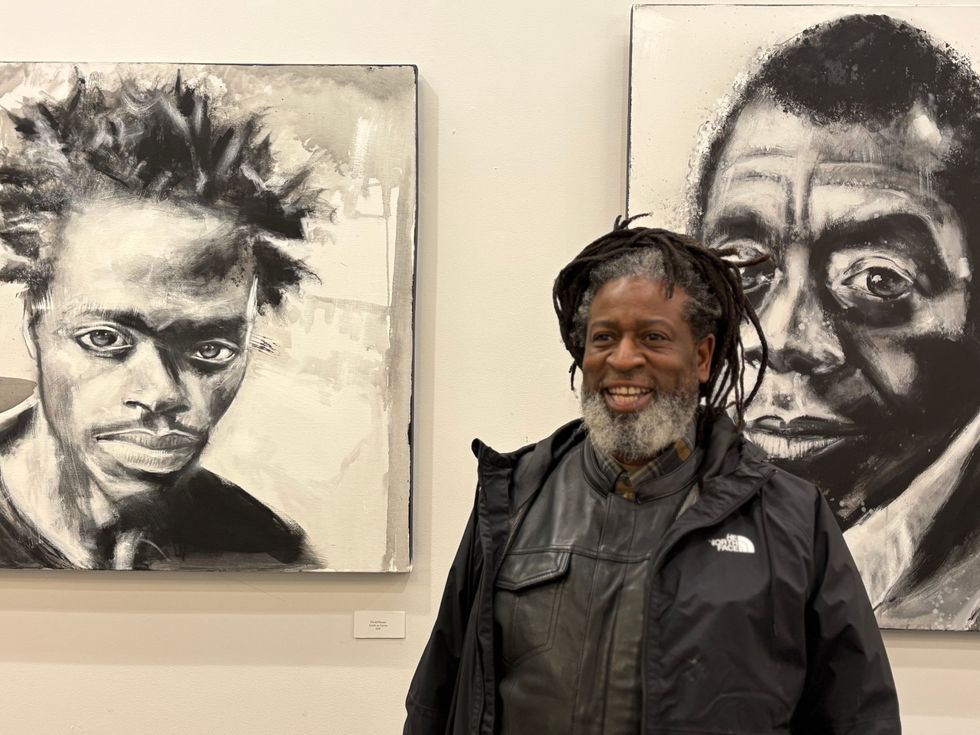
Storm’s artistic training began at New Haven’s Educational Center for the Arts. His talent earned him a full scholarship to the Arts Institute of Boston, then Boston’s Museum School, where he painted seven oversized portraits of influential Black figures — in seven days — for his final project. Those works became the backbone of his early exhibitions, including at Howard University’s National Council for the Arts.
Storm has created several community murals like the 2009 READ Mural featuring local heroes, and several literacy and wellness murals at the Stetson Branch Library in New Haven. Today, he teaches and works, he said, “wherever I set up shop. Sometimes I go outside. Sometimes I’m on top of roofs. Wherever it is, I get the job done.”
His deep ties to education made a high school gallery an especially meaningful stop. “No one really knew who these people were except maybe John Lennon,” Storm said of the portraits in the show. “It’s really important for them to know James Baldwin and Shirley Chisholm. And now they do.”
The exhibition includes a wide list of subjects: James Baldwin, Shirley Chisholm, Redd Foxx, Jasper Johns, Marilyn Manson, William F. Buckley, Harold Hunter, John Lennon, as well as two deeply personal works — a portrait of Tracy Sherrod (“She’s a friend of mine… She had an interesting hairdo”) and a tribute to his late friend Nes Rivera. “Most of the time I choose my subjects because there are things I want to see,” Storm said.
Storm’s paintings, which he describes as “full frontal figuratism,” rely on drips, tonal shifts, and what feels like emerging depth. His process moves quickly. “It depends on how fast it needs to get done,” he said. “Sometimes I like to take the long way up the mountain. Instead of doing an outline, I just start coloring, blocking things off with light and dark until it starts to take shape.”
He’s currently in a black-and-white phase. “Right now, I’m inspired by black and white, the way I can really get contrast and depth.”
Work happens on multiple canvases at once. “Sometimes I’ll have five paintings going on at one time because I go through different moods, and then there’s the way the light hits,” he said. “It’s kind of like cooking. You’ve got a couple things going at once, a couple things cooking, and you just try to reach that deadline.”
For Wilbur, who has studied studio arts “ever since I was really young” and recently applied early decision to Vassar, the experience has been transformative. For Storm — an artist who built an early career painting seven portraits in seven days and has turned New York’s subway corridors into a makeshift museum — it has been another chance to merge artmaking with education, and to pass a torch to a new generation of curators.
Le Petit Ranch offers animal-assisted therapy and learning programs for children and seniors in Sheffield.
Le Petit Ranch, a nonprofit offering animal-assisted therapy and learning programs, opened in April at 147 Bears Den Road in Sheffield. Founded by Marjorie Borreda, the center provides programs for children, families and seniors using miniature horses, rescued greyhounds, guinea pigs and chickens.
Borreda, who moved to Sheffield with her husband, Mitch Moulton, and their two children to be closer to his family, has transformed her longtime love of animals into her career. She completed certifications in animal-assisted therapy and coaching in 2023, along with coursework in psychiatry, psychology, literacy and veterinary skills.
Le Petit Ranch operates out of two small structures next to the family’s home: a one-room schoolhouse for animal-assisted learning sessions and a compact stable for the three miniature horses, Mini Mac, Rocket and Miso. Other partner animals include two rescued Spanish greyhounds, Yayi and Ronya; four guinea pigs and a flock of chickens.
Borreda offers programs at the Scoville Library in Salisbury, at Salisbury Central School and surrounding towns to support those who benefit from non-traditional learning environments.
“Animal-assisted education partners with animals to support learning in math, reading, writing, language and physical education,” she said. One activity, equimotricité, has children lead miniature horses through obstacle courses to build autonomy, confidence and motor skills.

She also brings her greyhounds into schools for a “min vet clinic,” a workshop that turns lessons on dog biology and measuring skills into hands-on, movement-based learning. A separate dog-bite prevention workshop teaches children how to read canine body language and respond calmly.
Parents and teachers report strong results. More than 90% of parents observed greater empathy, reduced anxiety, increased self-confidence and improved communication and cooperation in their children, and every parent said animal-assisted education made school more enjoyable — with many calling it “the highlight of their week.”
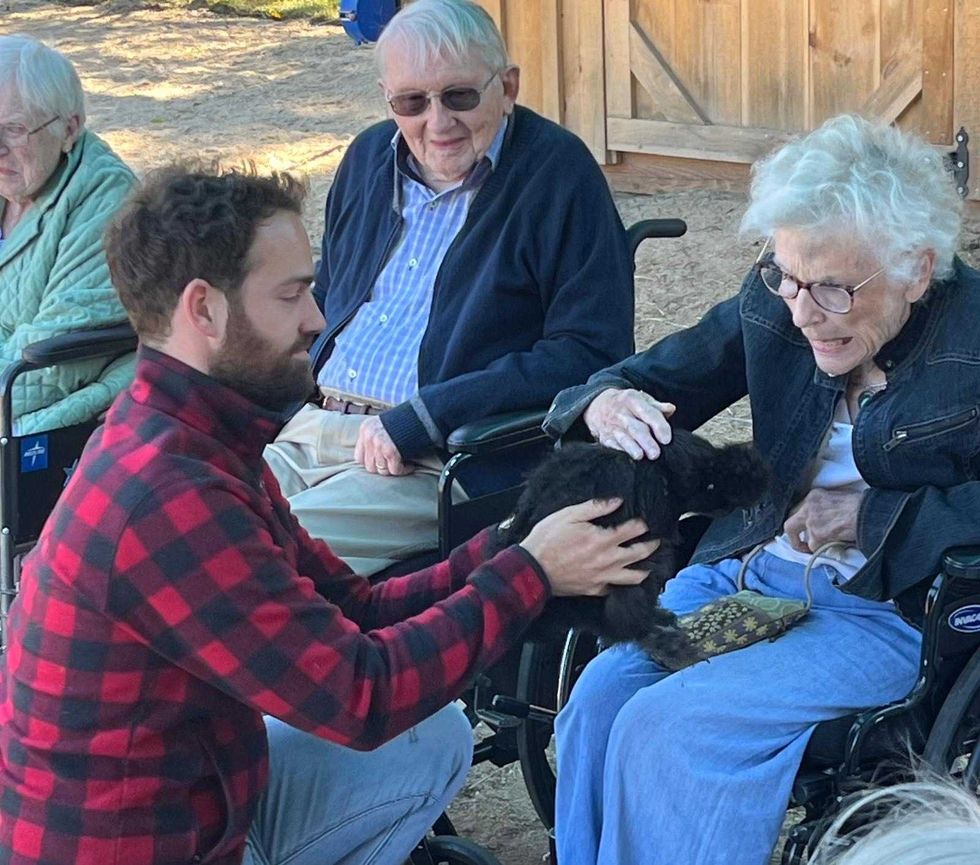
Le Petit Ranch also serves seniors, including nursing home residents experiencing depression, social withdrawal or reduced physical activity. Weekly small-group sessions with animals can stimulate cognitive function and improve motor skills, balance and mobility.
Families can visit Le Petit Ranch for animal- assisted afterschool sessions, Frech immersion or family walks. She also offers programs for schools, libraries, community centers, churches, senior centers and nursing homes.
For more information, email info@lepetitranch.com, visit lepetitranch.com, follow @le.petit.ranch on Instagram or call 413-200-8081.